I find myself saying, “there’s something about this race”, about a lot of races! There’s something about the Arc of Attrition, there’s something about the South Downs Way 100, there’s something about the Brecon Beacons Ultra and there’s most definitely something about the Transvulcania Ultra, that makes it special. So special I want to keep going back to do it every year.
Transvulcania 2016 and 2017
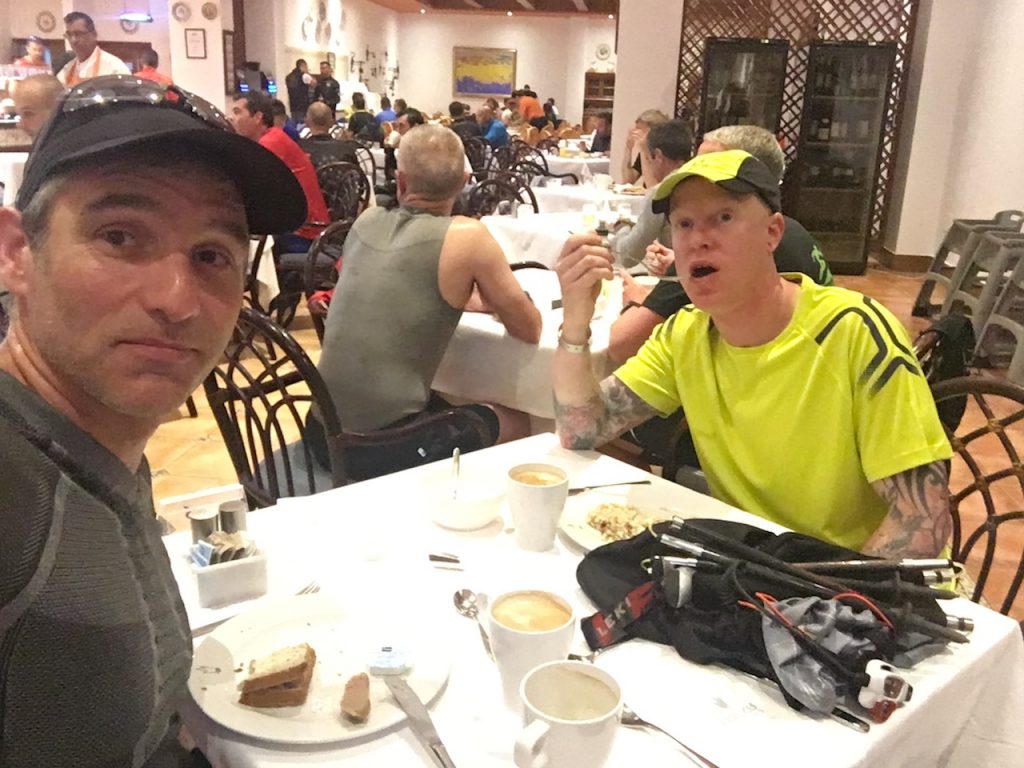 You may well have seen the video I made of my first Transvulcania experience in 2016. At the time it was by far the toughest race I had done. Richard and I were determined to go back and run it faster. So we did in 2017. I didn’t make a race film but I did record a vlog of the week’s holiday in La Palma. I’ll wait here if you want to go and watch those videos before coming back to read the rest of the 2018 edition.
You may well have seen the video I made of my first Transvulcania experience in 2016. At the time it was by far the toughest race I had done. Richard and I were determined to go back and run it faster. So we did in 2017. I didn’t make a race film but I did record a vlog of the week’s holiday in La Palma. I’ll wait here if you want to go and watch those videos before coming back to read the rest of the 2018 edition.
One of the great things about the race for us is that we can make it a really nice holiday for our two families. My children get on well with Richard’s children and our wives run together and console themselves that they are not alone as ultra running widows. La Palma is the smallest of the Canary Islands but the most diverse in terms of complex topography and ecology. It is known as the Green Island, in comparison to the other, rather more barren, volcanic looking islands in the Canaries like Lanzarote or Fuerteventura.
Volcanos
 La Palma is certainly volcanic though. In fact, the Teneguia Volcano on the south of the island erupted as recently as 1971, the last recorded volcanic activity in Spain. The Transvulcania Ultra race begins at the foot of the Teneguia Volcano at the Fuencaliente Lighthouse and the hotel where we have stayed for all our visits is just a short drive from there, go to their blog and find further information. It’s a huge hotel complex with 11 swimming pools and great for the children.
La Palma is certainly volcanic though. In fact, the Teneguia Volcano on the south of the island erupted as recently as 1971, the last recorded volcanic activity in Spain. The Transvulcania Ultra race begins at the foot of the Teneguia Volcano at the Fuencaliente Lighthouse and the hotel where we have stayed for all our visits is just a short drive from there, go to their blog and find further information. It’s a huge hotel complex with 11 swimming pools and great for the children.
If you haven’t watched my videos or read my previous reports on the race…..what the hell have you been doing? In brief, the Transvulcania Ultra is a 74 kilometre (46 mile) race along the ridge of the Cumbre Vieja and Cumbre Nueva (old summit and new summit). Reaching a peak of 2400 metres elevation at the highest point of Roque de los Muchachos, the entire race accumulates approximately 4400 metres total elevation gain. The terrain is hugely varied from tarmac road to volcanic sand, sharp, loose, volcanic rock, beach, dry river bed, stone steps and pine forest paths. Definitely no soft, grassy fields though.
Elite Runners
The Transvulcania Ultra is the second race of the year in the Migu Sky Runner World Series and is attended by some of the world’s finest ultra runners. Kilian Jornet, Luis Alberto Hernando, Sage Canaday, Chris Vargo, Anna Frost and Emily Forsberg have all run here. This year’s big names were Ida Neilson, back to try and win the race for a third year on the trot, and double UTMB champion Xavier Thevenard. These elite runners complete the race in between 7 and 9 hours. Richard and I were hoping to scrape in under 12 hours and many would be out there for 15-17 hours.
You start in the dark. Head torches are one of only four items in the mandatory kit list. The others being a phone, space blanket and hydration system. No base layer, body bag, spare batteries or waterproof jacket required. Amazing really given the varied terrain, the altitude and relative danger inherent in taking part in a race of this nature. In my experience over the previous two years, the weather has been hot, but not baking. There has been some cloud cover at lower altitude both years which gave us some relief when coming down off the volcano in the latter part of the run.
Down at the Lighthouse
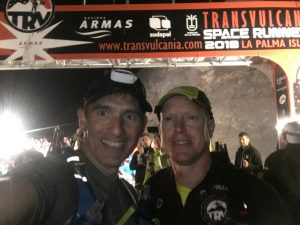 This year, however, it was all change. We arrived at the start by bus. These days it’s simply not possible to reach the start on foot or by car as the roads are completely sealed off to any traffic other than the official race busses. These collect runners from various locations at ungodly times. Our bus left the hotel at just after 4am for the short journey, but some people were on busses as early as 3am in the north of the island. We have previously been dropped right at the lighthouse. This year we were dumped at the top of the hill and had to walk down.
This year, however, it was all change. We arrived at the start by bus. These days it’s simply not possible to reach the start on foot or by car as the roads are completely sealed off to any traffic other than the official race busses. These collect runners from various locations at ungodly times. Our bus left the hotel at just after 4am for the short journey, but some people were on busses as early as 3am in the north of the island. We have previously been dropped right at the lighthouse. This year we were dumped at the top of the hill and had to walk down.
It’s a strange wait in the dark with 2000 others, milling about until the start pen is opened and we all make our way down to the scrubland area below the lighthouse This is where the race actually begins, as close to sea level as possible without actually going on to the beach. There are lights, there’s loud music, the announcer interviews the star runners and builds the tension as a huge digital clock, projected onto the cliff face, counts the minutes down. It’s so exciting and I doubt there are many experiences like it anywhere in the world.
The Start
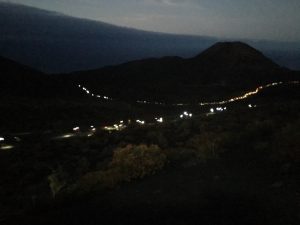 When the gun goes off at 6am it’s a free for all. Pushing and shoving to get ahead so you don’t get trapped when the route becomes single track. This year the route was altered because of this very problem. It was becoming slightly too dangerous having so many people scrambling up the narrow path at the start of the GR131 trail. People would go off trail to get around and clamber over very sharp rocks or through deep black sand. It was manic. So in an attempt to minimise this, at the gun, we ran up the hill and round the lighthouse as usual, but then on the winding tarmac road for a few hundred metres before joining the GR131 trail a little further up.
When the gun goes off at 6am it’s a free for all. Pushing and shoving to get ahead so you don’t get trapped when the route becomes single track. This year the route was altered because of this very problem. It was becoming slightly too dangerous having so many people scrambling up the narrow path at the start of the GR131 trail. People would go off trail to get around and clamber over very sharp rocks or through deep black sand. It was manic. So in an attempt to minimise this, at the gun, we ran up the hill and round the lighthouse as usual, but then on the winding tarmac road for a few hundred metres before joining the GR131 trail a little further up.
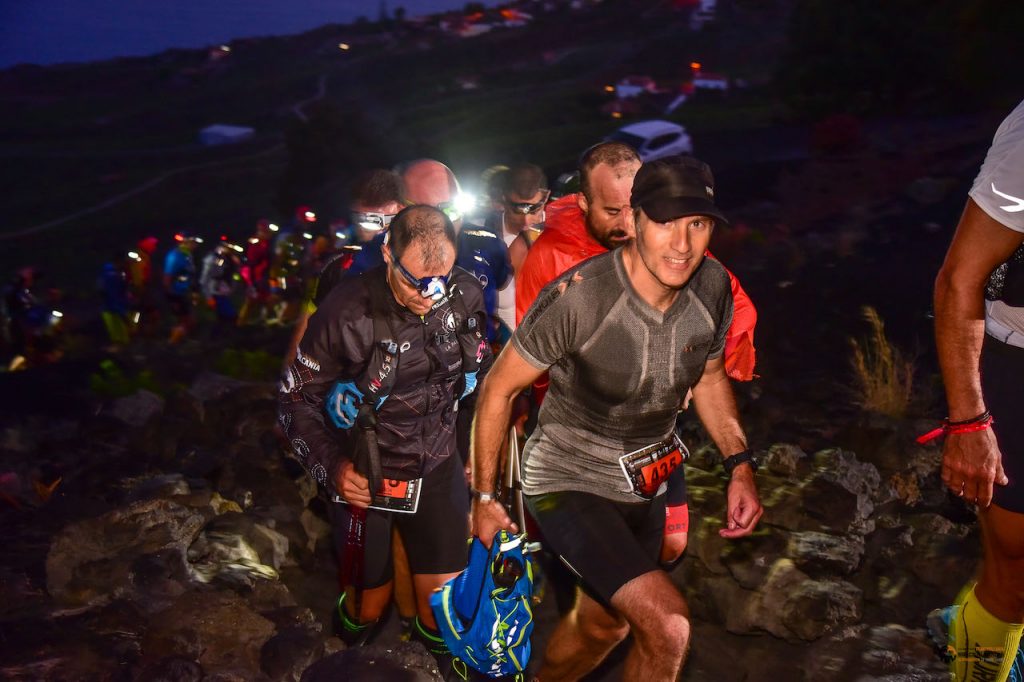 However, the field had certainly not thinned out enough by this point and we all came to a standstill and then a slow walk as we joined the track. Many still scrambled around the sides to get ahead. If you want a decent start, it pays to get yourself as near the front as possible or you will be walking or coming to a stop for large portions of the first 7 kilometres. This first section takes you up past the Teneguia Volcano and on around the side of the larger San Antonio volcano. It’s a procession of lights to rival any midnight lantern festival or Disneyland’s Electrical Parade!
However, the field had certainly not thinned out enough by this point and we all came to a standstill and then a slow walk as we joined the track. Many still scrambled around the sides to get ahead. If you want a decent start, it pays to get yourself as near the front as possible or you will be walking or coming to a stop for large portions of the first 7 kilometres. This first section takes you up past the Teneguia Volcano and on around the side of the larger San Antonio volcano. It’s a procession of lights to rival any midnight lantern festival or Disneyland’s Electrical Parade!
Early Climbing
The first aid station is in the town of Los Canarios. During our holiday, whenever we drive anywhere, we have to pass right through Los Canarios to get anywhere. This year my wife and children surprised us by meeting us here to cheer us on. I had taken my head torch off just before this, so was able to hand it to Victoria on the way through. Handy, I thought, not to have that extra bit of weight to carry. Pity I had eaten so many pizzas and burgers in the days before the race!! On we went. From the raucous crowds and loud music of Los Canarios at 7am, we were quickly into the quiet beauty of the forest above the town.
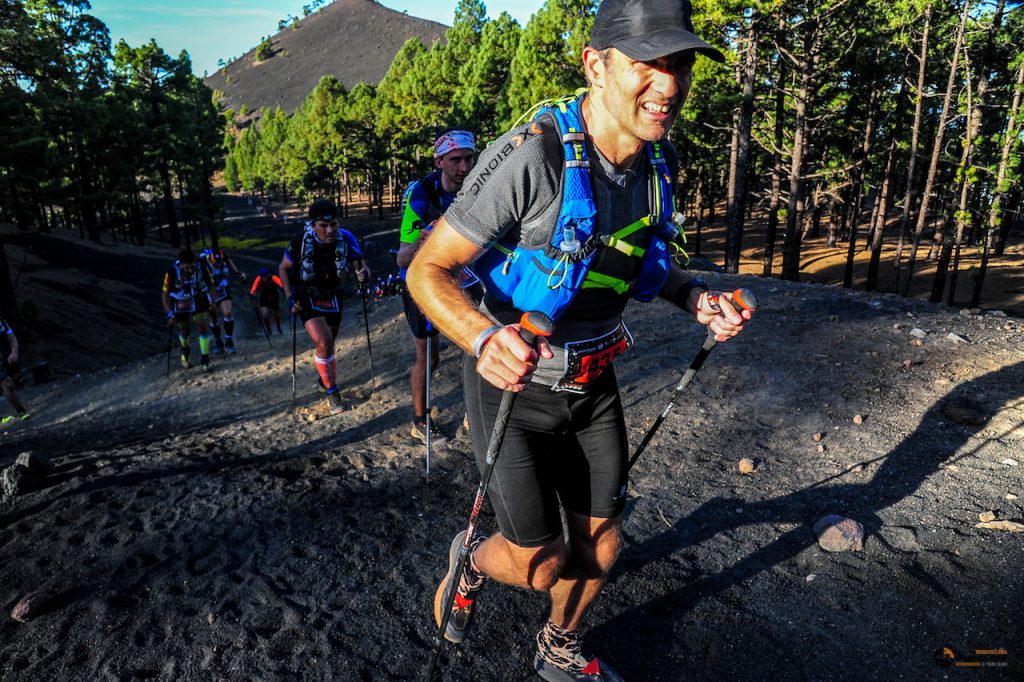 Still climbing, the route winds around more vents, all part of the original big volcano. Underfoot the sand saps the energy in your legs from early on. The loose rock makes good foot placement vital but the rising sun is stunning as it glints through the trees. Out in the distance on a good day, you can see the highest peak in the Canary Islands, Mount Teide on Tenerife. Today though, there was low cloud cover and there was no view out to the east of the island. It was at this point I was passed by the ever speedy Clare Prosser, previous winner of the Brecon Beacons Ultra, the RAT and the Classic Quarter, on her way to a sub 12 hour finish. The second aid station Las Deseadas is at 10 miles. There had been quite a breeze on the way up and the higher we got the windier it became.
Still climbing, the route winds around more vents, all part of the original big volcano. Underfoot the sand saps the energy in your legs from early on. The loose rock makes good foot placement vital but the rising sun is stunning as it glints through the trees. Out in the distance on a good day, you can see the highest peak in the Canary Islands, Mount Teide on Tenerife. Today though, there was low cloud cover and there was no view out to the east of the island. It was at this point I was passed by the ever speedy Clare Prosser, previous winner of the Brecon Beacons Ultra, the RAT and the Classic Quarter, on her way to a sub 12 hour finish. The second aid station Las Deseadas is at 10 miles. There had been quite a breeze on the way up and the higher we got the windier it became.
El Pilar Aid Station
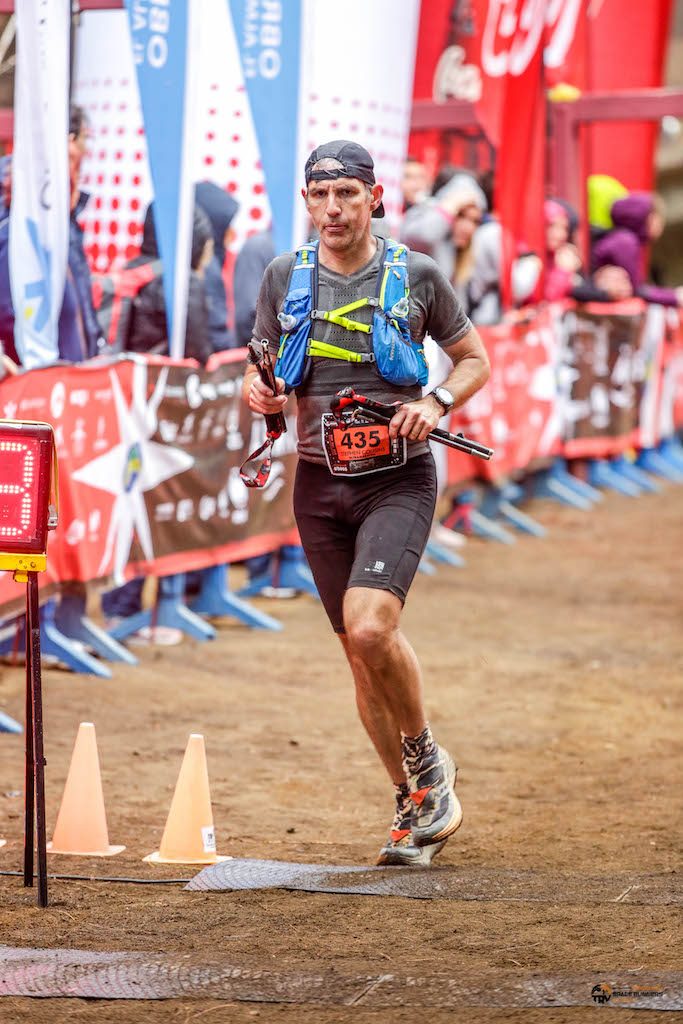 Approaching the cloud line, not only was it blowing a gale but the wind was icy cold. There are sections of the run where you are exposed to both sides of the island and the wind blows horizontally from one side to the other. Usually, it’s warm and sunny and this wind is a welcome relief from the heat. However, on this occasion, it felt like we were running in a snowstorm on the Alps! As we started our descent to the big aid station at El Pilar I have never seen the ground so muddy and although it wasn’t raining, water drops falling from the trees were so heavy it may as well have been.
Approaching the cloud line, not only was it blowing a gale but the wind was icy cold. There are sections of the run where you are exposed to both sides of the island and the wind blows horizontally from one side to the other. Usually, it’s warm and sunny and this wind is a welcome relief from the heat. However, on this occasion, it felt like we were running in a snowstorm on the Alps! As we started our descent to the big aid station at El Pilar I have never seen the ground so muddy and although it wasn’t raining, water drops falling from the trees were so heavy it may as well have been.
I grabbed some sandwiches and a chocolate croissant at El Pilar and carried on, aware that the marathon would be starting soon and hoards of runners would swoop past me. I was also keen to see Ryan Sands and the other elite runners. El Pilar is also where the half marathon finishes having started an hour later down at the lighthouse. The leaders had sped past us on the descent. I was trying to record a few bits of video on my way around and did manage to catch the marathon leaders on one of the only flatish sections of the run between the El Pilar and La Revention aid stations.
The Heart of the Volcano
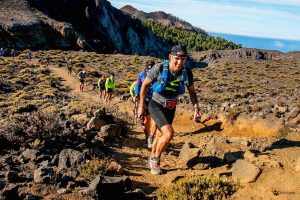 I felt quite good running this section and then starting the climb through the clouds again. The icy wind blast was even stronger this time and it was an absolute relief when we finally climbed high enough to make it out of the top of the clouds and into glorious sunshine. Although I was cold, I had been more worried about losing my cap than anything else. But some people were really covered up with three or four layers on. The top of the ridge is where the Transvulcania Ultra gets really stunning and it was even more so this time. In the previous editions of the race I had run, there had been low cloud cover over the whole island. Once we got up high, it was apparent that only the right, eastern side of the island was in cloud. The western side was clear right down to the coast and from very early on we could see the finish miles away in the distance. We could also see down to the centre of the caldera.
I felt quite good running this section and then starting the climb through the clouds again. The icy wind blast was even stronger this time and it was an absolute relief when we finally climbed high enough to make it out of the top of the clouds and into glorious sunshine. Although I was cold, I had been more worried about losing my cap than anything else. But some people were really covered up with three or four layers on. The top of the ridge is where the Transvulcania Ultra gets really stunning and it was even more so this time. In the previous editions of the race I had run, there had been low cloud cover over the whole island. Once we got up high, it was apparent that only the right, eastern side of the island was in cloud. The western side was clear right down to the coast and from very early on we could see the finish miles away in the distance. We could also see down to the centre of the caldera.
It is an amazing sight and an incredible experience. It’s much of what makes Transvulcania such a great race. Not only is it tough with big elevation and very technical trails, but it’s also completely beautiful the entire way around. Do not be fooled though. When you reach the top of the ridge, that is by no means the end of the climbing. I was feeling quietly confident in my performance. The plan was to finish under 12 hours and I made it to halfway, 37 kilometres, in exactly 6 hours. With the bulk of the climbing done I was in with a chance of success. But the cold wind was gone. The sun was out. It was really, really hot and I don’t like the heat.
Slowing Down
After running along the ridge for 5 more kilometres the route drops down to the aid station at Pico de la Nieve. Having run a marathon we had 32 kilometres to go. There is a huge climb out of this aid station to get back up to the top. It’s really steep and very technical too. I was also still in a line of people, some of whom were slower than me, some of whom were faster. But you just have to go at the speed everyone else is going, or you risk getting into difficulty. I fell at one point because I tried to overtake someone and I was a little over confident.
By 44 kilometres I was beginning to realise that perhaps my timing was out. I generally split the race into three 25km sections. If I can do each section in around 4 hours then I should be fine. But the middle section always seems to take longer than I want it to. It’s a continual up and down on the ridgeline and I was losing time. My feet were starting to hurt. It felt like I had huge blisters on each big toe and I kept kicking rocks and making it worse. I don’t know how much the heat affected me but I was certainly starting to throw lots of water over myself at each aid station.
Roque de Los Muchachos
There is a big aid station at the highest point on La Palma, Roque de Los Muchachos. You pass a number of white domed observatories and then a sign tells you it’s only 500 metres to the next aid station. The thing is, you can see the white tent from miles away and it doesn’t ever seem to get any closer. When you finally arrive at the 500 metres to go sign, it’s basically a 500 metres climb up steep switchbacks. One girl had collapsed and was being carried up to the aid station by a couple of medics. There are medical teams sat in position every few miles along the entire route.
Roque de Los Muchachos is about 53 kilometres into the race. To be on course for a 12 hour finish I had needed to be there in 8 hours 30 minutes. But I didn’t make it until 9 hours and 7 minutes. I knew I couldn’t get down the other side of the ridge quick enough, even if I ran the best downhill I’ve ever run. The first year I did Transvulcania, I completely crumbled on the downhill. Last year I nailed it totally. This year, I knew what was coming and I knew I’d done it before, but that didn’t stop it beating me again. My legs just didn’t have it. I tried and I made decent headway, but just not fast enough. My feet hurt and I could feel a pull in my left calf.
Locals with Hose Pipes
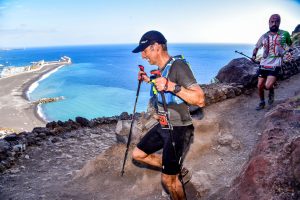 To get down that 20km steep, technical decent you need to be confident. To be confident, you need everything to be going well, and it wasn’t. The route has some forest cover on the way down, but it was basically blazing sunshine for the entire drop. The second last aid station at El Time marks the end of the sky running and from this point, the run starts heading through populated areas. Some of the locals come out with buckets of water or hose pipes or drinks. There’s even one guy who regularly gives away cans of beer or a glass of wine here. I was happy for him to simply tip a bucket of water over my head though!
To get down that 20km steep, technical decent you need to be confident. To be confident, you need everything to be going well, and it wasn’t. The route has some forest cover on the way down, but it was basically blazing sunshine for the entire drop. The second last aid station at El Time marks the end of the sky running and from this point, the run starts heading through populated areas. Some of the locals come out with buckets of water or hose pipes or drinks. There’s even one guy who regularly gives away cans of beer or a glass of wine here. I was happy for him to simply tip a bucket of water over my head though!
Underfoot it is so difficult. There’s a stony section like a dry river bed of sharp rock. On the flat, it would be hard enough but on this descent, it’s a miracle I’ve yet to crack my skull in the three years I’ve attempted it. Eventually, with 7 kilometres to go, you start running on tarmac. It’s still really steep downhill, but at least you can put one foot in front of the other without worrying too much about placement. I saw one guy walking backwards as I did two years previously. With just 5km left I hit the famous switchbacks at Tazacorte. It’s amazing to hear the music and the MC down on the beach at the marathon finish line when you are still way up high on the cliff edge coming down the switchbacks.
Spraying Coke in my Face
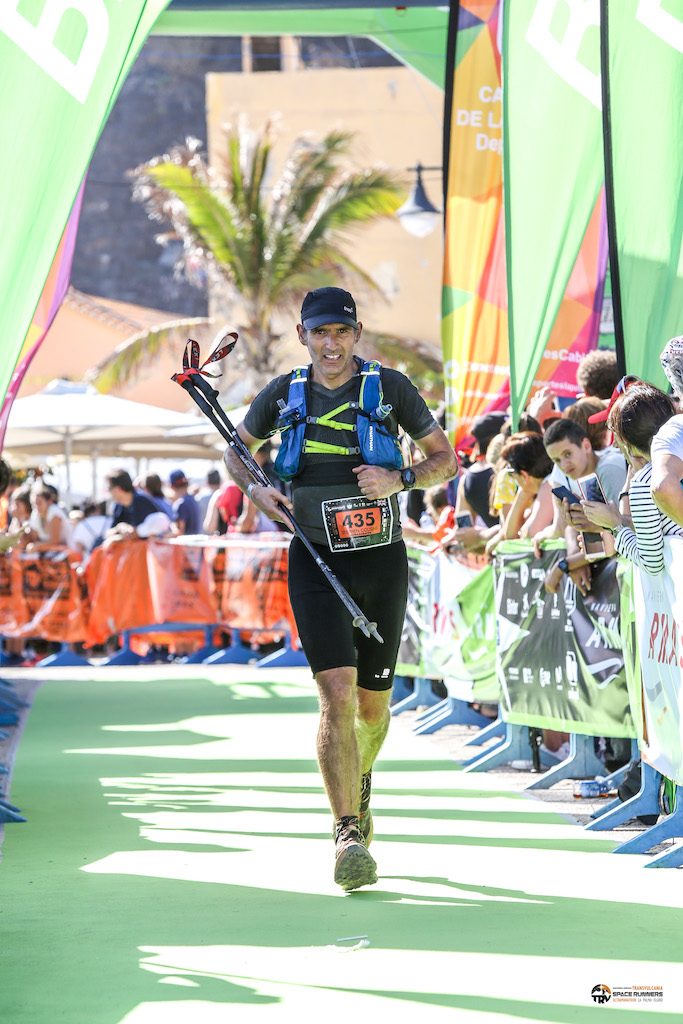 I was still running ok, just not fast enough to make up any time. But there were people dropping like flies. I even saw marathon runners with less than 400 metres to go, just sitting exhausted on the steps unable to drag themselves any further. I suppose they got up after a while and made it down but the hot weather was not being kind to many. I eventually made it down to the promenade at Tazacorte. It’s always a bit of a buzz because there’s a nice, enthusiastic crowd to cheer you through the marathon finish and into the final aid station. By now, I was only just going to make it in under 13 hours. Until one final comedy of errors intervened.
I was still running ok, just not fast enough to make up any time. But there were people dropping like flies. I even saw marathon runners with less than 400 metres to go, just sitting exhausted on the steps unable to drag themselves any further. I suppose they got up after a while and made it down but the hot weather was not being kind to many. I eventually made it down to the promenade at Tazacorte. It’s always a bit of a buzz because there’s a nice, enthusiastic crowd to cheer you through the marathon finish and into the final aid station. By now, I was only just going to make it in under 13 hours. Until one final comedy of errors intervened.
I took both soft flasks out and handed them to the volunteer. I said ‘water’ and then ‘Coke’. ‘Coke’ she replied and off she went. I grabbed a slice of watermelon and chatted briefly to Dave Douglas from the Transvulcania FB group. As the lady handed me back my bottles I dropped one and it split. Not to worry I thought, I’m nearly finished. Off I went. Now, in order to cool myself down, I quite regularly spray water from my soft flask on to my face. I was half way along the promenade when I decided to do this. I got a shock when I got a face full of Coke-a-Cola. “Oh no!” thought I. She’s put my bottles in the wrong way round. So I proceeded to squirt my face from the other bottle, only to get another eyeful of Coke! “Aaarrgghhhh, where’s my water??!!”
Ravine of Sorrows
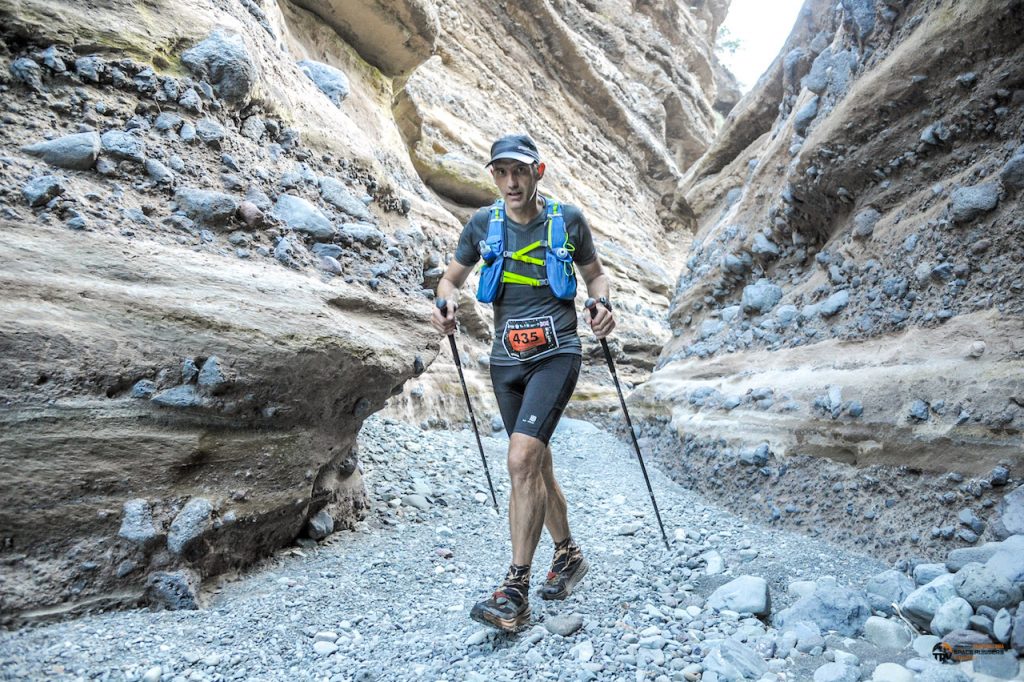 Now, I know it’s only 4 km but in the heat, I had to have water. So I turned back to the aid station. This probably cost me 3 or 4 minutes and certainly a lot of mental energy. From here, you are directed off the promenade, onto the black sand beach and under the bridge to the Ravine of Sorrows. Yes, that’s what it’s called!! It’s another awesome bit of the course though. You run through what can only be described as a mini canyon. The terrain is big rounded beach stones. Quite difficult to negotiate but runnable if you still have some energy left in your legs. After one mile of that, the Transvulcania Ultra presents you with its final cheeky sting in the tail. A 300 metre climb from sea level up to the finish at Los Llanos. That’s 300 metres elevation gain, not distance.
Now, I know it’s only 4 km but in the heat, I had to have water. So I turned back to the aid station. This probably cost me 3 or 4 minutes and certainly a lot of mental energy. From here, you are directed off the promenade, onto the black sand beach and under the bridge to the Ravine of Sorrows. Yes, that’s what it’s called!! It’s another awesome bit of the course though. You run through what can only be described as a mini canyon. The terrain is big rounded beach stones. Quite difficult to negotiate but runnable if you still have some energy left in your legs. After one mile of that, the Transvulcania Ultra presents you with its final cheeky sting in the tail. A 300 metre climb from sea level up to the finish at Los Llanos. That’s 300 metres elevation gain, not distance.
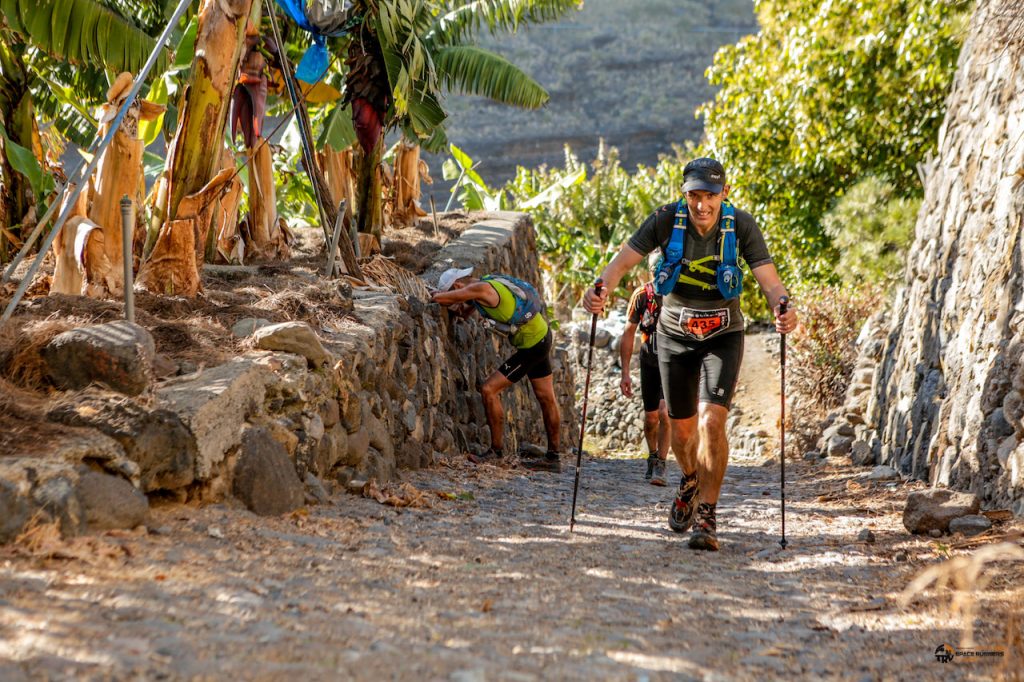 If almost you’re done in, this climb will finally kill you off. It’s not technical, but it doesn’t need to be. It’s just steep, really steep. Here in the UK, we have not fully accepted the use of poles, but in mainland Europe, they use them all the time and with good reason. Poles will seriously save your quads from collapsing. They are also very good to cry over when you look ahead and all you can see is another cobbled street stretching up in front of you. Thankfully there were three locals on hand on the way up with hoses. Honestly, you don’t know the joy of a cold spray of water until you’ve run 72 kilometres to the top of a volcano and back down.
If almost you’re done in, this climb will finally kill you off. It’s not technical, but it doesn’t need to be. It’s just steep, really steep. Here in the UK, we have not fully accepted the use of poles, but in mainland Europe, they use them all the time and with good reason. Poles will seriously save your quads from collapsing. They are also very good to cry over when you look ahead and all you can see is another cobbled street stretching up in front of you. Thankfully there were three locals on hand on the way up with hoses. Honestly, you don’t know the joy of a cold spray of water until you’ve run 72 kilometres to the top of a volcano and back down.
Crossing the Line with Ellis
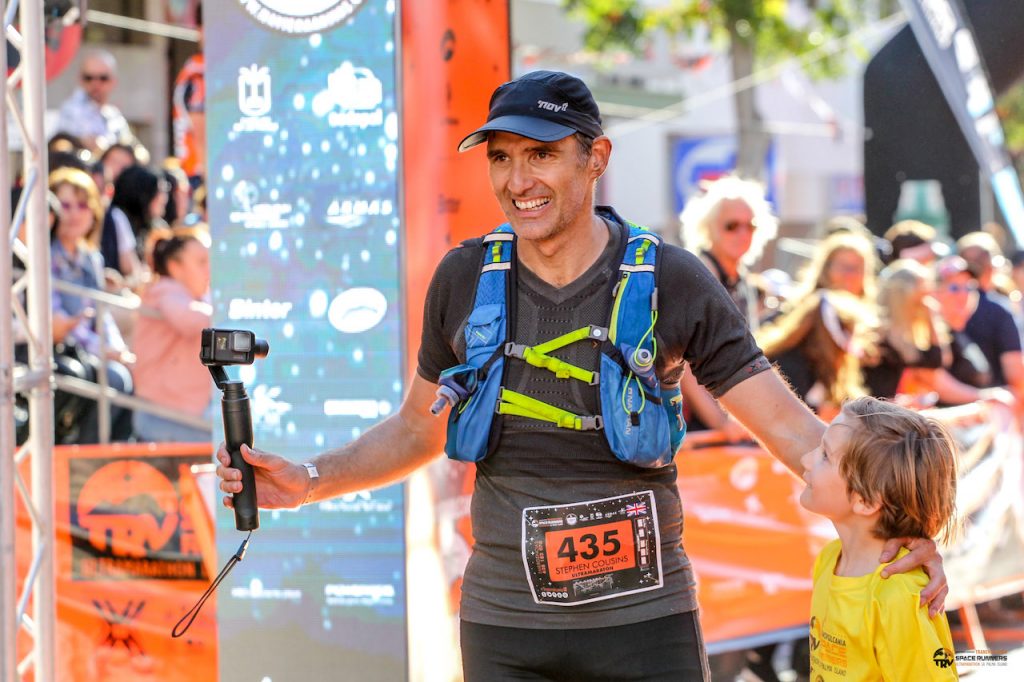 When you eventually reach Los Llanos you have about a mile to run along a blue bike lane on the road to the finish. In another small change from previous years, the finish was moved to allow more space. It’s now just a dead straight run along the road. You can see the finish from a mile away and the streets are lined with people cheering you in. Many are sitting in cafe’s or bars along the route. Some of the bars have special Transvulcania parties going on. It’s amazing and a truly memorable ending to a remarkable run. I was still using my poles to drag my tired body to the finish line. I was still going to make it in just under 13 hours until I came upon my wife and children.
When you eventually reach Los Llanos you have about a mile to run along a blue bike lane on the road to the finish. In another small change from previous years, the finish was moved to allow more space. It’s now just a dead straight run along the road. You can see the finish from a mile away and the streets are lined with people cheering you in. Many are sitting in cafe’s or bars along the route. Some of the bars have special Transvulcania parties going on. It’s amazing and a truly memorable ending to a remarkable run. I was still using my poles to drag my tired body to the finish line. I was still going to make it in just under 13 hours until I came upon my wife and children.
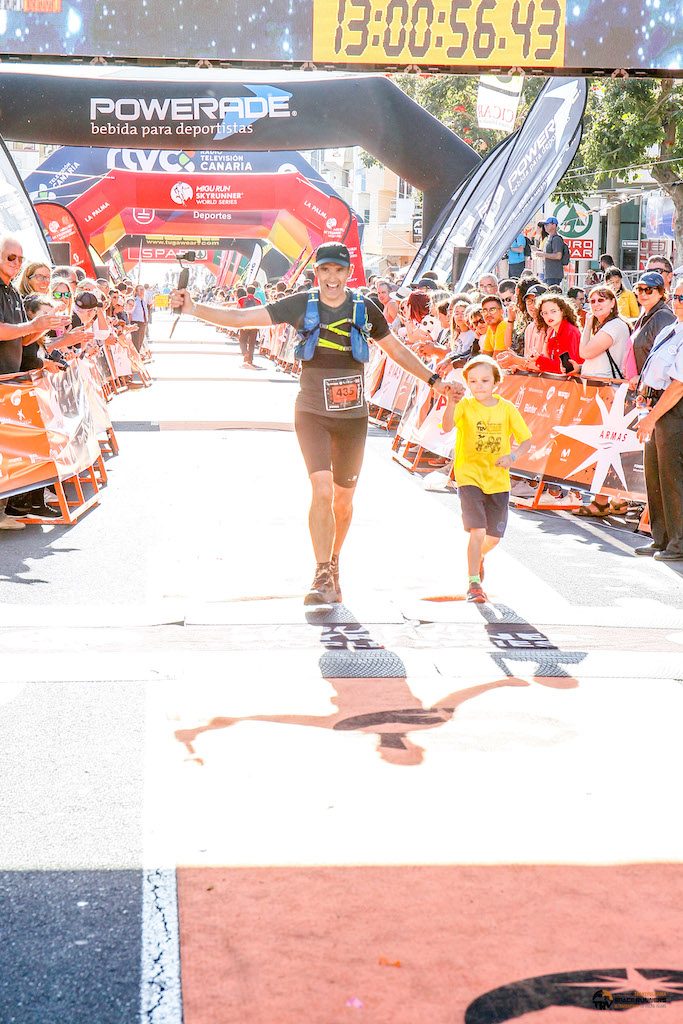 My youngest son, Ellis wanted to run the final few hundred metres with me. Now, what’s more important, sprinting to the line to finish in 12 hours 59 minutes and 30 seconds or jogging to the line holding your son’s hand and taking it all in and finishing in 13 hours and 19 seconds? I don’t know what you would do, but these are the things that dreams and memories are made of. Clare Prosser shouted over and waved to us as we ran in through the cheering crowds. We crossed the line together and Ellis presented me with my finisher’s medal. I was over an hour slower than I had wanted to be. It would have been great to get in under 12 hours but there are lots of reasons why I didn’t make it and none of them really matter. I collapsed in a heap for a good 20 minutes after that. I was done.
My youngest son, Ellis wanted to run the final few hundred metres with me. Now, what’s more important, sprinting to the line to finish in 12 hours 59 minutes and 30 seconds or jogging to the line holding your son’s hand and taking it all in and finishing in 13 hours and 19 seconds? I don’t know what you would do, but these are the things that dreams and memories are made of. Clare Prosser shouted over and waved to us as we ran in through the cheering crowds. We crossed the line together and Ellis presented me with my finisher’s medal. I was over an hour slower than I had wanted to be. It would have been great to get in under 12 hours but there are lots of reasons why I didn’t make it and none of them really matter. I collapsed in a heap for a good 20 minutes after that. I was done.
Richard Breaks 12 Hours
I’m very pleased to say that Richard did manage under 12 hours. Well under in fact. He came in in 11 hours 51 minutes and that’s after a storming Three Forts Challenge result the week before. So huge congratulations to him. There’s something very special about the Transvulcania Ultra that makes us want to keep going back year after year. But I think we are both done with Transvulcania for a bit. We’ve done it three years in a row and it’s time to do something else. However, we will return because……well, because it’s Transvulcania. It’s the best race we’ve ever done and we love it, even though it has completely broken me twice. It takes about 30 seconds of ‘I hated that and I’m never doing it again’ to ‘OMG that was awesome and we HAVE to do it again’.
A big ‘well done’ to our friend Paul Coates, who was inspired, cajoled, conned into running the ultra with us this year. He finished in just over 15 hours and his last 5km was way faster than both Richard’s and mine. Paul has made a couple of videos. This video is of the race itself. There’s also this erotic post race interview with me in which I rub myself down with oil as I’m talking. It really is a ‘must see’. My film is simply a few dodgy iPhone clips pasted together.
We are probably off to Tenerife for the Blue Trail next year, but sure as a sure thing can be, we will be back to traverse the volcano again before too long. If you have enjoyed my Transvulcania Ultra 2018 race report, please do give it a ‘like’ and share it with anyone who might be interested in doing the race in the future. Thanks.


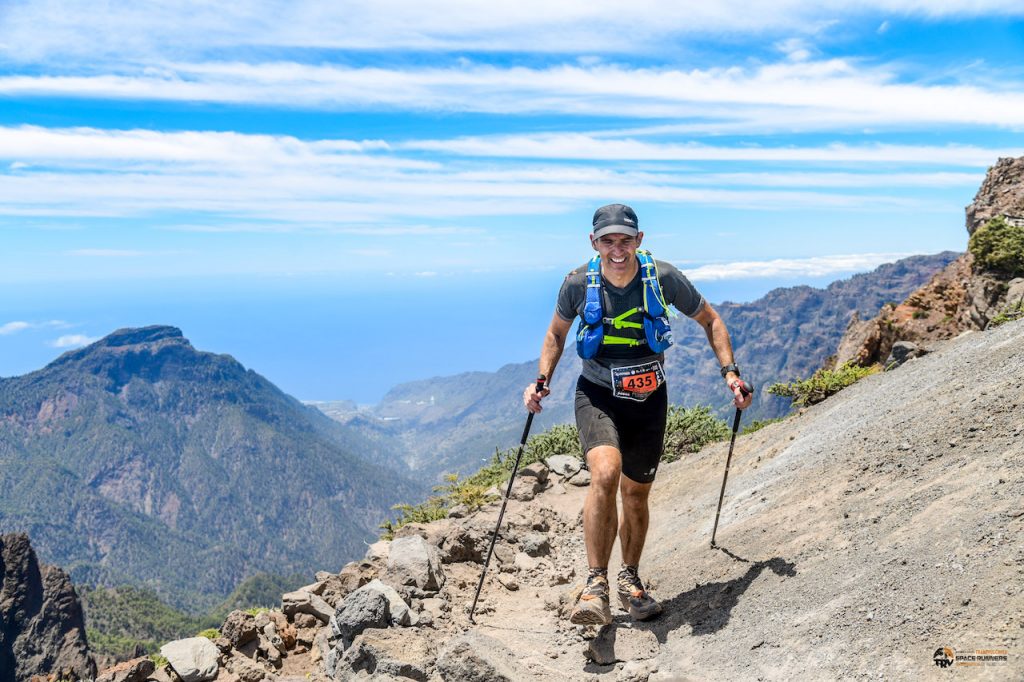
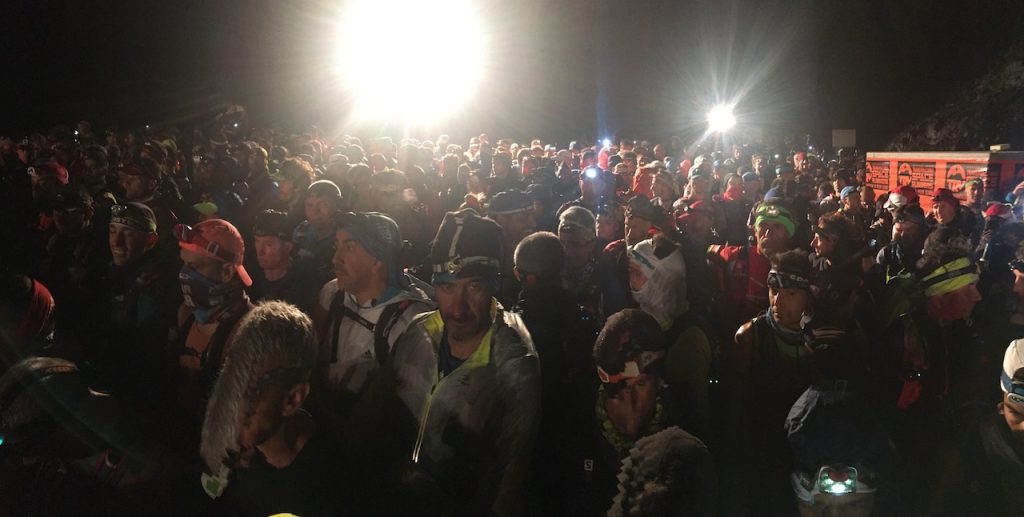
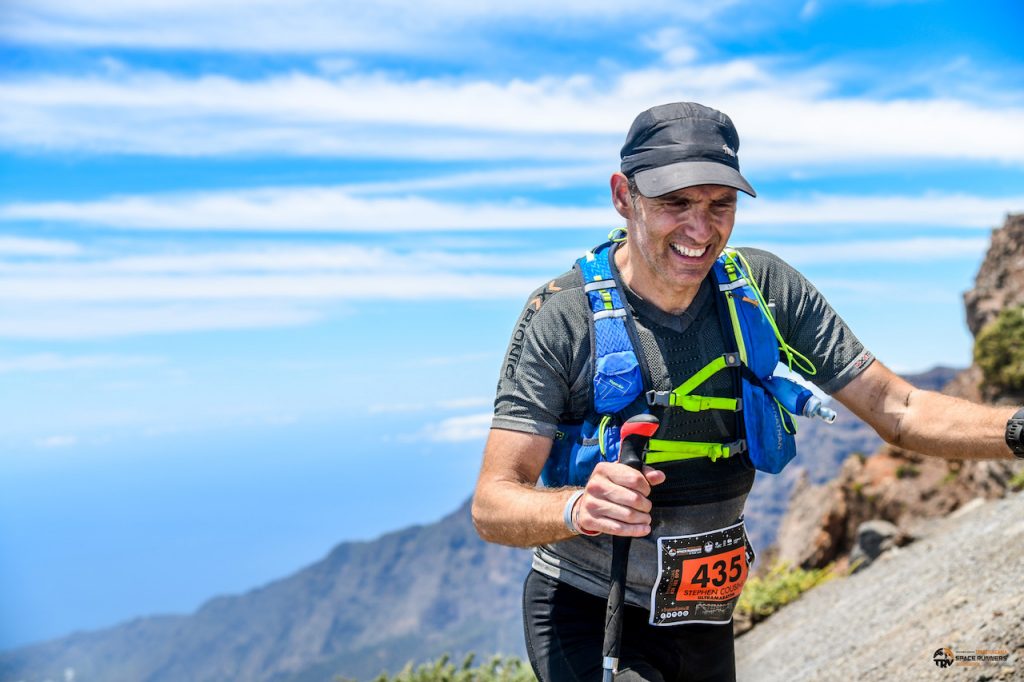
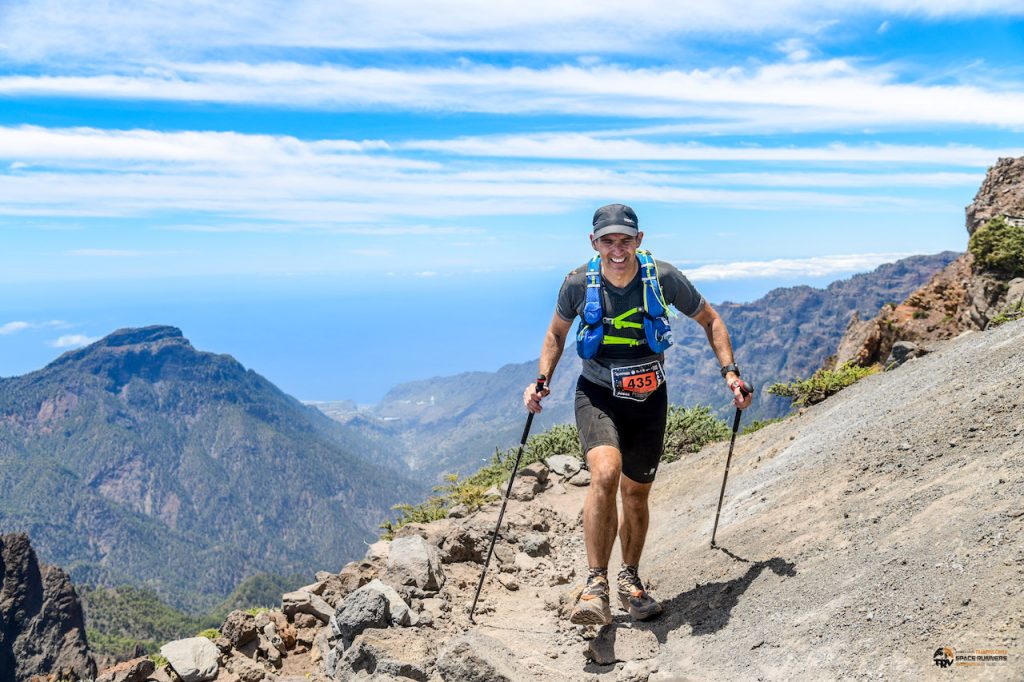
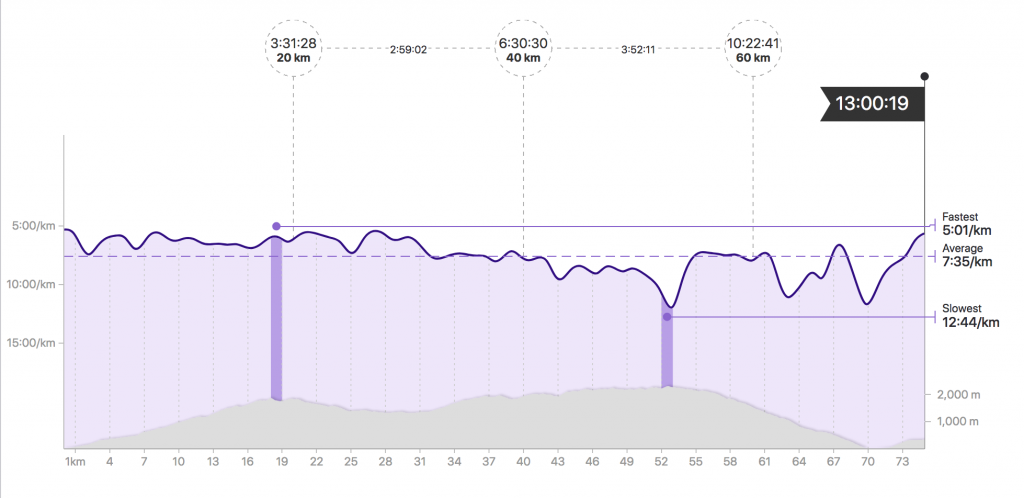
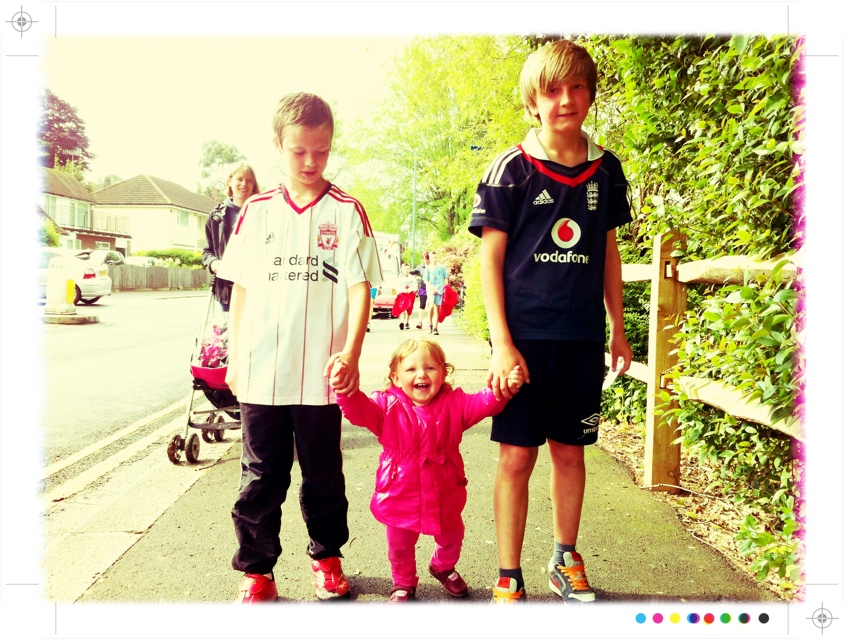
Hi Stephen,
I have been looking for a gear list from yourself but can’t seem to find anything? I saw the gimbal review and like it and I am in the market for a vest and just wanted to know your experiences.
Thanks for the content I do enjoy it.
Also the article that your wrote about too much filming during comps was on the money and I think it is only time before these athletes realise their efforts are being effected by the camera more than they realise. As an amateur film maker myself I saw this effect everyone from kayakers to competitive off-road drivers.
Thanks
Dan